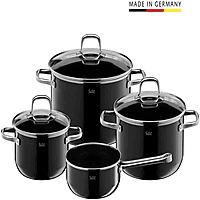
Silit Comodo Topfset Induktion 4-teilig, Kochtopf Set mit Glasdeckel, Edelstahl poliert, Induktions Töpfe Set unbeschichtet : Amazon.de: Küche, Haushalt & Wohnen

Silit Topfset Silargan schwarz 4-teilig in Friedrichshain-Kreuzberg - Kreuzberg | eBay Kleinanzeigen

WMF Silit Toskana Kochtopf-Set, 10-tlg. (21.0928.5458) ab € 186,90 (2023) | Preisvergleich Geizhals Deutschland

Silit Achat Topfset Induktion 4-teilig, Kochtopf Set mit Glasdeckel, Edelstahl teilmattiert, Induktions Töpfe Set unbeschichtet : Amazon.de: Küche, Haushalt & Wohnen

Amazon.com: Silit Pot Set 4-Piece Diamant Pouring Rim Glass Lid Stainless Steel Polished Suitable for Induction Hobs Dishwasher-Safe : Home & Kitchen

Silit Elegance Line Topfset Induktion 4-teilig, Kochtopf Set mit Glasdeckel, Silargan Funktionskeramik, Induktions Töpfe Set nickelfrei : Amazon.de: Küche, Haushalt & Wohnen

Silit Alicante Topfset Induktion 4-teilig, Kochtopf Set mit Glasdeckel, Edelstahl poliert, Induktions Töpfe Set unbeschichtet, Transparent : Silit: Amazon.de: Küche, Haushalt & Wohnen

Silit Alicante Topfset Induktion 4-teilig, Kochtopf Set mit Glasdeckel, Edelstahl poliert, Induktions Töpfe Set unbeschichtet,Transparent : Amazon.de: Küche, Haushalt & Wohnen

Amazon.com: Silit Pot Set 4-Piece Diamant Pouring Rim Glass Lid Stainless Steel Polished Suitable for Induction Hobs Dishwasher-Safe : Home & Kitchen

Silit Topf-Set Silargan 4tlg Top gepflegt Gebraucht in Nordrhein-Westfalen - Kamen | eBay Kleinanzeigen















